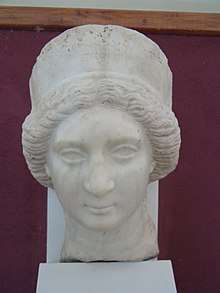Musa of Parthia

Musa was Queen of the Parthian Empire from c. 2 BC to 4 AD. She is called as Thermusa by Josephus and is also known as Thea Urania (Astarte).
Marriage
Musa was a Roman concubine given by the Roman Emperor Augustus (27 BC – 14 AD) to King Phraates IV of Parthia (37–2 BC). Around the same time, Augustus recovered the eagle standards (Aquilae) lost by Marcus Licinius Crassus in the Battle of Carrhae in 53 BC.
Phraates IV made her his favored wife; he appointed her son Phraates V (2 BC – 4), commonly called Phraataces (a diminutive form), as his successor. She persuaded Phraates IV to send his other sons to Rome as hostages.
Reign with Phraates V
With all rivals out of the way, Musa and Phraataces poisoned the king and assumed the throne in 2 BC. They appear together on their coins, and were apparently co-rulers.
Josephus alleges that Musa then married Phraates V, and, this being unacceptable to the Parthians, they rose up and overthrew them, offering the crown to Orodes III (who ruled briefly in 6).
References

- Josephus, Antiquities of the Jews, xviii, 2–4.
- Royal Egyptian Genealogy, Ptolemaic Dynasty: Cleopatra Selene
- Emma Strugnell: Thea Musa, Roman Queen of Parthia. In: Iranica Antiqua 43, 2008, S. 275–298.
Musa of Parthia Born: Unknown Died: After AD 4 | ||
| Preceded by Phraates IV |
Great Queen (Shah) of Parthia 2 BC – AD 4 |
Succeeded by Orodes III |